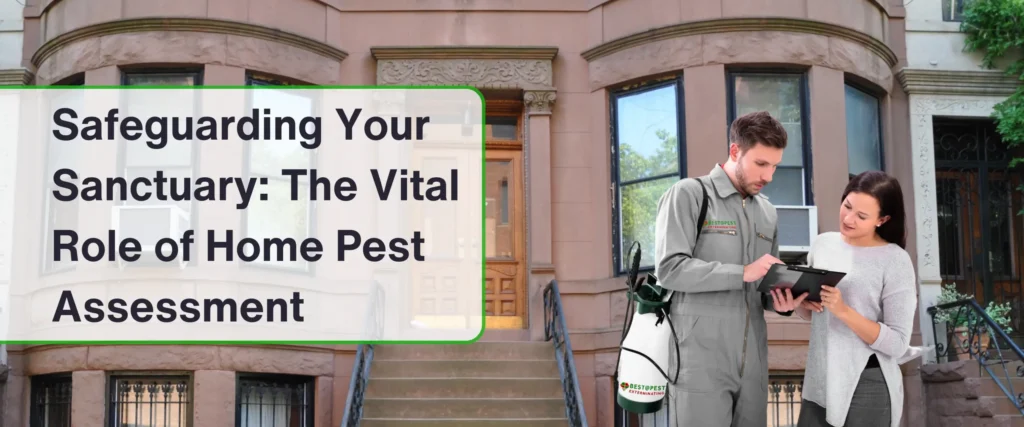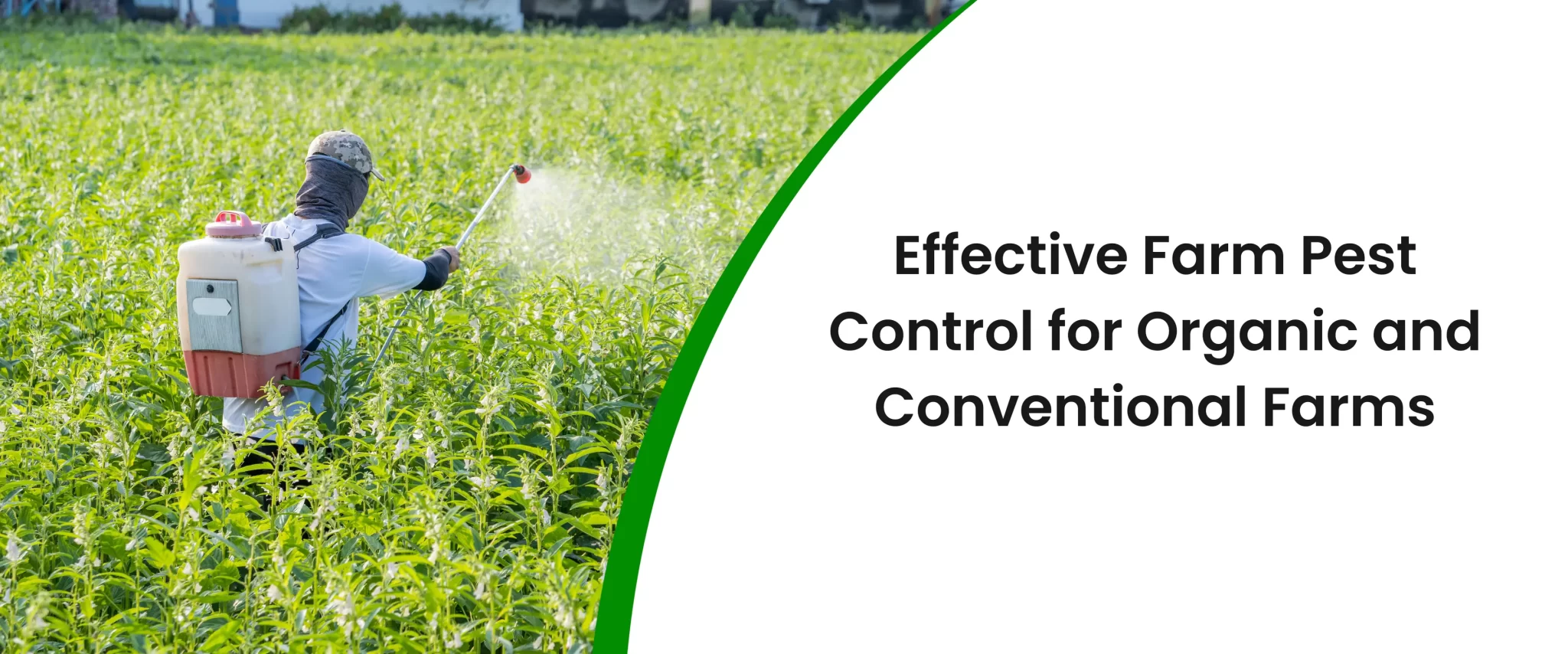
Comprehensive Guide to Effective Farm Pest Control for Organic and Conventional Farms
From juicy berries to crisp lettuce, American farms provide the bounty that graces our tables. But lurking beneath the surface of this idyllic image is a constant battle – the fight against farm pests. These unwelcome guests can wreak havoc on crops, reducing yields and impacting the livelihoods of farmers.
This comprehensive guide dives deep into the world of farm pest control, exploring strategies for both organic and conventional farms. We’ll explore the importance of pest control, the challenges it presents, and most importantly, effective solutions to keep your crops thriving.
Understanding Farm Pest Control
What is Farm Pest Control and Why is it Important?
Farm pest control is the practice of managing populations of insects, rodents, weeds, and other organisms that can damage crops and livestock. Effective pest control is crucial for both organic and conventional farms. Here’s why:
- Protects Crops: Pests can devour leaves, burrow into fruits, and spread diseases, significantly reducing crop yields and quality.
- Maintains Farm Profitability: Lost crops translate to lost income for farmers. Effective pest control helps ensure a bountiful harvest and financial stability.
- Ensures Food Safety: Certain pests can contaminate crops with harmful bacteria, making them unfit for consumption. Pest control safeguards the health of consumers.
Common Farm Pests in the USA
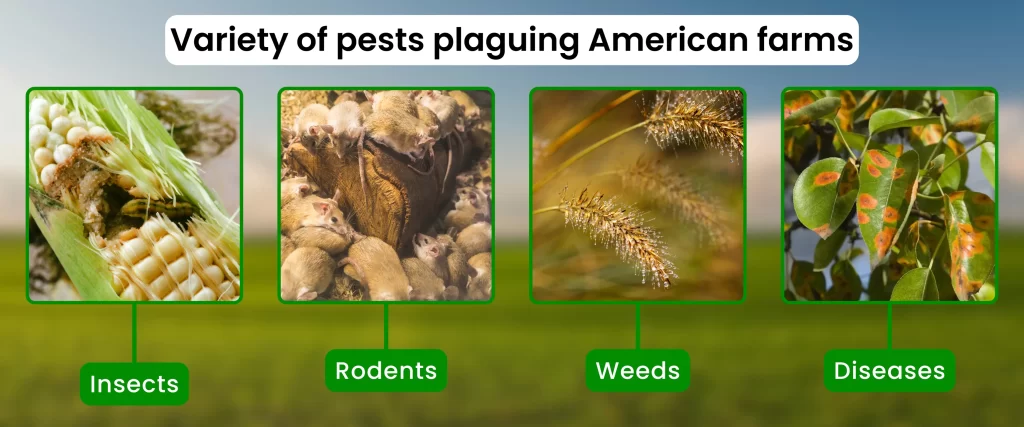
A wide variety of pests can plague American farms, including:
- Insects: Corn earworms, aphids, Colorado potato beetles, and grasshoppers are just a few examples.
- Rodents: Mice, rats, and voles can damage crops and stored grains.
- Weeds: From dandelions to crabgrass, weeds compete with crops for water and nutrients.
- Diseases: Fungal diseases like blight and rust can devastate crops.
Challenges Faced in Farm Pest Control
Keeping pests at bay is no easy feat. Here are some of the challenges farmers face:
- Pest Resistance: Over Reliance on certain pesticides can lead to pest resistance, rendering them ineffective.
- Environmental Impact: Conventional pesticides can harm beneficial insects and pollute soil and water sources.
- Cost: Implementing pest control strategies can be expensive for farmers.
How Are Pests Controlled in Organic Farming?
Organic farming is a holistic approach to agriculture that emphasizes sustainability, biodiversity, and the use of natural processes. The core principles include:
Avoidance of Synthetic Chemicals:
Organic farming strictly prohibits the use of synthetic pesticides, herbicides, and fertilizers. Instead, it relies on natural alternatives to manage soil fertility and control pests.
Enhancing Soil Health:
Healthy soil is the foundation of organic farming. Practices like crop rotation, green manuring, and the use of compost and organic matter improve soil structure and fertility, creating an environment that supports healthy plant growth and resilience against pests.
Biodiversity:
Organic farms often cultivate a diverse range of crops and plants. This diversity creates a balanced ecosystem that can naturally regulate pest populations and reduce the risk of widespread pest infestations.
Use of Non-GMO Seeds:
Organic farming uses non-genetically modified seeds, which supports biodiversity and maintains the integrity of the ecosystem.
Animal Welfare:
In livestock farming, organic practices ensure animals are raised in natural, stress-free environments, which contributes to their health and reduces the need for chemical treatments.
Natural Pest Control Methods
Organic farmers employ a variety of natural pest control methods to manage and mitigate pest problems without relying on synthetic chemicals. Key methods include:
Cultural Controls:
- Crop Rotation: Rotating crops disrupts pest life cycles and reduces the buildup of pests in the soil.
- Intercropping: Planting different crops in proximity can confuse pests and reduce the likelihood of infestations.
- Sanitation: Removing crop residues and weeds that can harbor pests helps minimize pest populations.
Mechanical Controls:
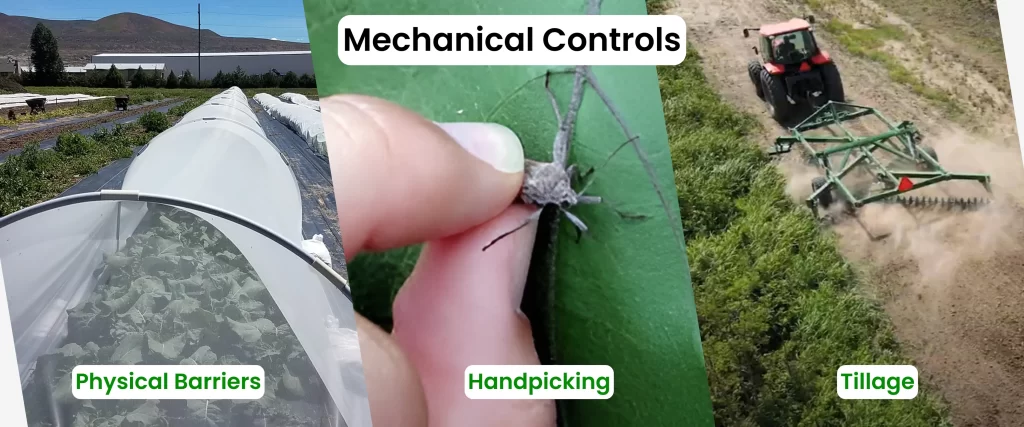
- Physical Barriers: Using row covers, nets, and traps to physically prevent pests from reaching the plants.
- Handpicking: Manually removing pests like caterpillars and beetles from plants.
- Tillage: Plowing and cultivating the soil to destroy pests and their habitats.
Biological Controls:
- Beneficial Insects: Introducing or encouraging natural predators like ladybugs, lacewings, and predatory beetles to control pest populations.
- Microbial Pesticides: Using naturally occurring bacteria, fungi, and viruses that target specific pests without harming beneficial organisms.
- Parasitic Wasps: Releasing parasitic wasps that lay their eggs in or on pest insects, eventually killing them.
Role of Beneficial Insects and Biological Control
Biological control involves the use of living organisms to manage pest populations, and beneficial insects play a crucial role in this strategy.
Predators:
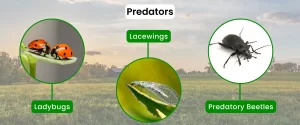
- Ladybugs: Feed on aphids, mites, and other soft-bodied insects.
- Lacewings: Their larvae, known as “aphid lions,” voraciously consume aphids, caterpillars, and other pests.
- Predatory Beetles: Ground beetles and rove beetles prey on a variety of soil-dwelling pests.
Parasitoids:
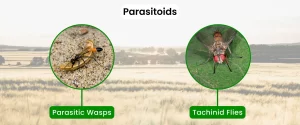
- Parasitic Wasps: These tiny wasps lay their eggs inside or on the bodies of pest insects. The developing wasp larvae consume the host, eventually killing it.
- Tachinid Flies: Parasitize caterpillars, beetles, and other pests by laying eggs on or in them.
Pathogens:

- Bacillus thuringiensis (Bt): A bacterium that produces toxins lethal to many insect larvae, particularly caterpillars.
- Beauveria bassiana: A fungus that infects and kills a wide range of insects by growing inside them.
Conservation and Augmentation:
- Habitat Enhancement: Creating environments that attract and support beneficial insects, such as planting flowering plants that provide nectar and pollen.
- Augmentative Releases: Periodically releasing large numbers of beneficial insects to boost their populations and enhance pest control.
How To Control Pests in Organic Farming
Organic farming presents a unique challenge – protecting crops without synthetic pesticides. But fear not, there’s an arsenal of effective methods at your disposal! This section explores Integrated Pest Management (IPM) strategies, cultural practices, organic pesticides, and monitoring techniques specifically for organic farms.
Integrated Pest Management (IPM) Strategies
IPM is a holistic approach to pest control that emphasizes prevention, monitoring, and using a combination of methods to manage pest populations. Here’s how IPM works in organic farming:
- Prevention is Key: Healthy soil, proper crop rotation, and choosing pest-resistant varieties all create a less hospitable environment for pests.
- Monitoring and Scouting: Regularly scouting your fields for signs of pests and damage allows for early intervention when populations are low.
- Action Thresholds: Don’t jump to control measures at the first sign of a pest. Set action thresholds – specific pest densities or damage levels – that trigger control methods.
- Multiple Control Tactics: IPM relies on a combination of methods, minimizing reliance on any single one and preventing pest resistance.
Cultural Practices to Reduce Pest Populations
These age-old practices promote a healthy farm ecosystem, making it less susceptible to pests:
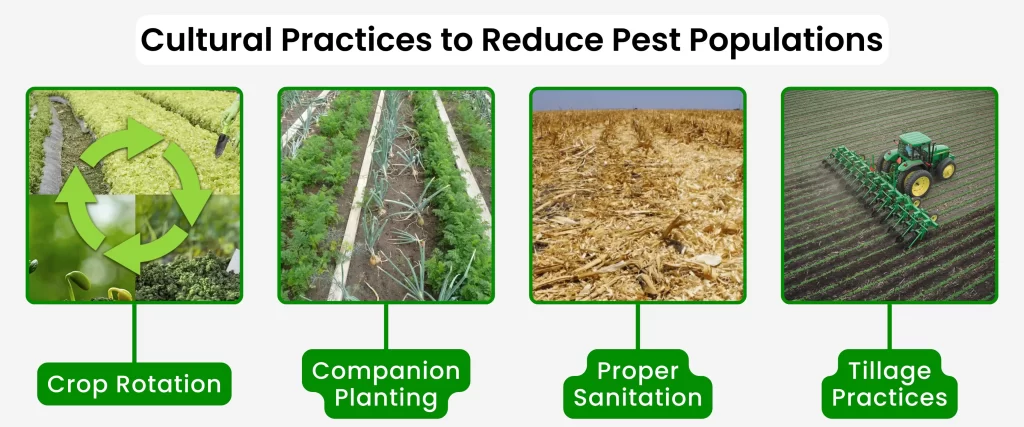
- Crop Rotation: Planting different crops in the same field each year disrupts pest life cycles and reduces their food sources.
- Companion Planting: Interplanting beneficial herbs and flowers like marigolds can deter pests or attract beneficial insects.
- Proper Sanitation: Removing crop residue after harvest and managing weeds can reduce pest harborage sites.
- Tillage Practices: Tilling techniques can disrupt pest life cycles and expose them to predators.
Monitoring and Early Detection Techniques
Early detection is crucial for successful organic pest control. Here are some techniques:
- Regular Field Scouting: Visually inspect your crops for signs of pests and damage.
- Use of Traps: Sticky traps, pheromone traps, and colored traps can attract and monitor specific pests.
- Recordkeeping: Track pest populations and damage levels over time to identify trends and adjust your pest control strategy.
Identifying Farms That Need Pest Control: Spotting Trouble Before It Spreads
Just like doctors diagnose patients, skilled farmers can diagnose pest problems in their fields and flocks. Early detection is key to preventing a small issue from snowballing into a major crop loss or livestock health crisis. This section equips you with the knowledge to identify farms needing pest control and emphasizes the importance of proactive measures.
Signs and Symptoms of Pest Infestations in Farms
A keen eye and a little know-how can help you identify signs of pest trouble on your farm. Here’s what to watch out for:
- Crops:
- Physical damage like chewed leaves, bored holes in fruits, or wilting plants.
- Presence of pests themselves – insects crawling on leaves, rodents leaving droppings near food sources.
- Signs of disease – discoloration, spots, or unusual growth patterns on leaves or fruits.
- Livestock:
- Unusual behavior – lethargy, scratching, or decreased appetite in poultry or livestock.
- Visible signs of pests – lice, mites, or ticks on animals.
- Unexplained weight loss or drop in egg production.
Economic Impact of Pests on Different Types of Farms
Left unchecked, pests can wreak havoc on your farm’s profitability. The impact varies depending on the type of farm:
- Crop Farms: Lost crops due to pest damage translate directly to lost income. Additionally, some pests can contaminate crops, rendering them unsellable.
- Livestock Farms: Diseased or stressed animals due to pests can lead to decreased weight gain, lower milk production, and higher veterinary bills.
- Poultry Farms: Similar to livestock farms, pest infestations can reduce egg production, increase mortality rates, and impact the overall health of the flock.
Importance of Regular Pest Assessments
Regular pest assessments are crucial for proactive farm management. Here’s why:
- Early Detection: Catching pest problems early allows for swift action before they escalate and cause significant damage.
- Reduced Costs: Early intervention is often cheaper than dealing with a full-blown infestation.
- Improved Crop Quality and Livestock Health: By managing pests effectively, you can ensure your crops and livestock remain healthy and productive.
Tailored Pest Control Solutions for Various Farm Types
The best pest control solution depends on the specific type of farm and the pest you’re facing. Here’s a glimpse into some tailored approaches:

- Crop Farms: Organic farms might utilize natural predators and cultural practices, while conventional farms might incorporate a combination of methods, including approved pesticides.
- Livestock Farms: Treatments might involve targeted insecticides for external parasites or dewormers for internal parasites. Biosecurity measures also play a vital role.
- Poultry Farms: Exclusion methods are used for pest control in poultry farms i.e rodents and wild birds out, combined with safe insecticides and fly control programs, are often key components of a poultry farm pest control plan.
Pest Control New Farm Strategies: Proactive Protection from the Start
It’s crucial to consider potential threats – pests. Taking a proactive approach with preventative measures and a well-defined pest control plan can make all the difference. This section explores how new farms can establish a strong foundation for pest control success.
Preventative Measures for New Farms
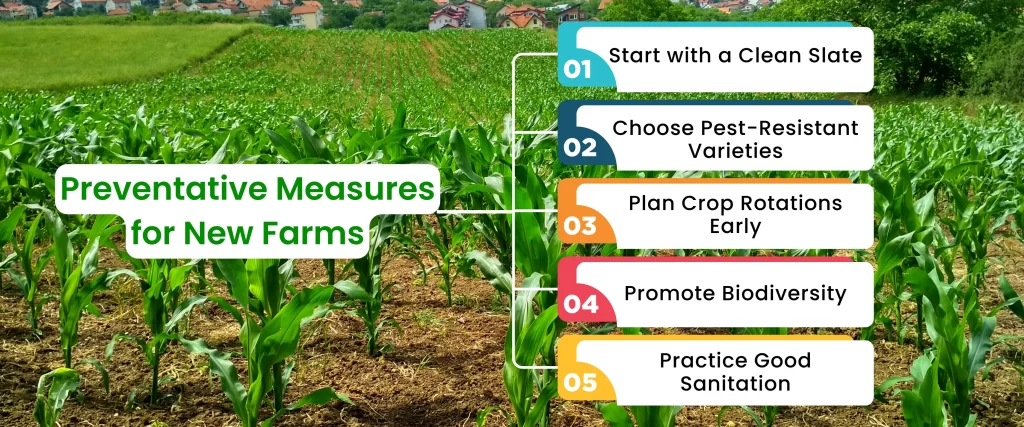
Prevention is always better than cure, and this rings especially true for pest control. Here are some key steps new farms can take:
- Start with a Clean Slate: Before planting your first crop or raising your first animal, thoroughly inspect your land and buildings for existing pest infestations. Address any problems before they escalate.
- Choose Pest-Resistant Varieties: Select crop varieties known for their resistance to common pests in your region. This reduces the need for future interventions.
- Plan Crop Rotations Early: Implement a crop rotation plan from the beginning. This disrupts pest life cycles and reduces their food sources in the soil.
- Promote Biodiversity: Encourage beneficial insects and wildlife like ladybugs and birds by planting hedgerows or providing nesting boxes. These natural predators can help keep pest populations in check.
- Practice Good Sanitation: Maintain a clean and organized farm environment. Regularly remove weeds, debris, and leftover feed sources that attract pests.
Establishing a Pest Control Plan from the Start
Don’t wait for a pest problem to arise before creating a plan. Here’s how new farms can establish a proactive pest control strategy:
- Identify Potential Pests: Research common pests that threaten crops and livestock in your area. Understanding their habits and weaknesses is crucial for effective control.
- Set Monitoring Protocols: Establish a regular monitoring schedule to scout your fields and animals for signs of pest activity. Early detection is key!
- Define Action Thresholds: Determine the level of pest infestation that warrants intervention. This helps avoid unnecessary use of pesticides while ensuring timely action when needed.
- Explore Integrated Pest Management (IPM): IPM is a holistic approach that combines multiple control methods like cultural practices, biological controls, and targeted pesticides. This minimizes reliance on any single method and reduces the risk of pest resistance.
Role of Technology in Modern Pest Control for Farms
Technology is revolutionizing farm management, and pest control is no exception. Here are some ways new farms can leverage technology:
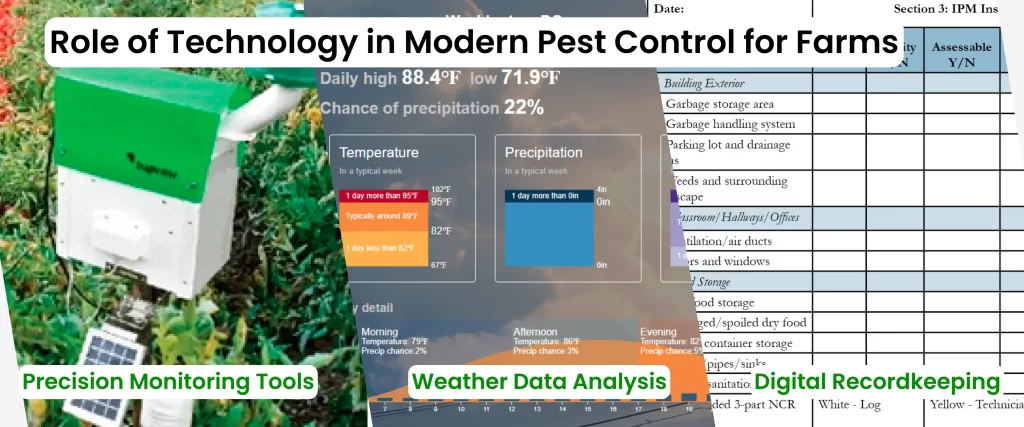
- Precision Monitoring Tools: Utilize tools like pheromone traps and remote sensing cameras to monitor pest activity with greater precision and efficiency.
- Weather Data Analysis: Weather data can predict pest outbreaks. By analyzing weather patterns, farmers can take preventative measures before pests become a problem.
- Digital Recordkeeping: Maintain digital records of pest sightings, control methods used, and their effectiveness. This data analysis helps refine your pest control plan over time.
Safeguarding Your Harvest and Livestock – The Path to Pest-Free Farming
Congratulations! You’ve reached the end of this comprehensive guide to farm pest control. We’ve explored the challenges and solutions for both organic and conventional farms, equipping you with the knowledge to protect your crops and livestock.
Recap of Key Points Discussed
Here’s a quick recap of the key takeaways:
- Pests are a constant threat to farm productivity and profitability.
- Organic farming relies on preventative measures, cultural practices, natural predators, and approved organic pesticides for pest control.
- Conventional farming may utilize a wider range of tools, including approved synthetic pesticides, alongside IPM strategies.
- Early detection is crucial for effective pest control in both organic and conventional farming.
- Integrated Pest Management (IPM) is a holistic approach that combines multiple control methods, minimizing reliance on any single tactic and reducing the risk of pest resistance.
- New farms can benefit greatly from implementing preventative measures and establishing a well-defined pest control plan from the start.
- Technology is playing an increasingly important role in farm pest control, offering tools for precision monitoring, data analysis, and informed decision-making.
Importance of Integrated and Proactive Pest Control Strategies
Remember, a successful pest control strategy is not just about reacting to problems – it’s about proactive prevention and integrated management. By taking a holistic approach, you can create a healthy farm ecosystem that is less susceptible to pest outbreaks.
FAQs
How can Best@PestNYC help with organic pest control?
Our experts can advise on organic farming best practices for pest prevention, identify and attract beneficial insects, and recommend approved organic pesticides when necessary.
What are the costs involved in pest control for farms?
The cost depends on the size and type of your farm, the specific pest problem, and the chosen control methods.
How often should farms be inspected for pests?
The frequency of inspection depends on the type of farm and pest risks.


